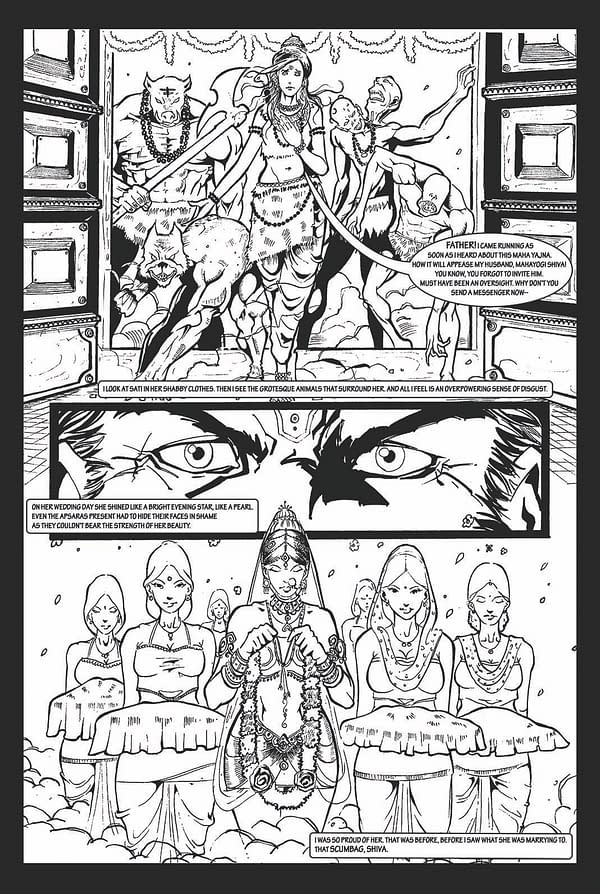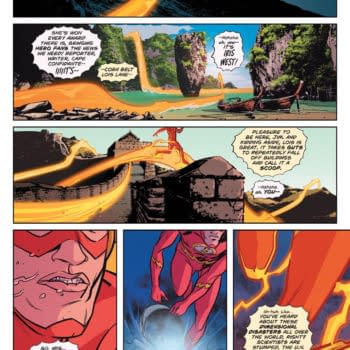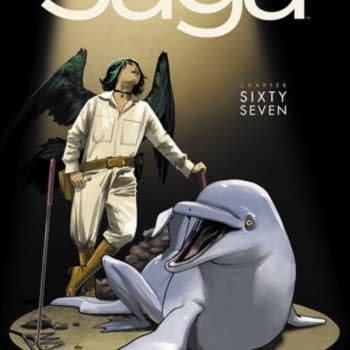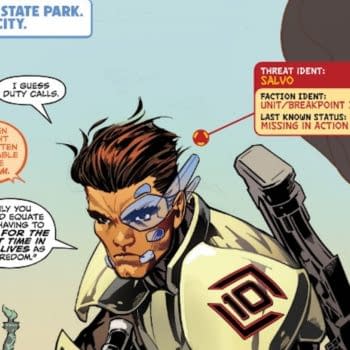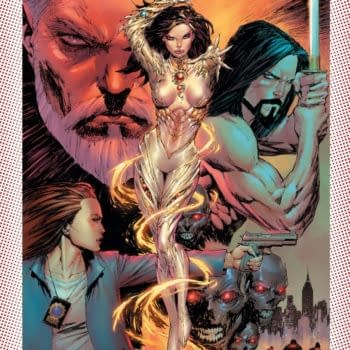Posted in: Comics, Recent Updates | Tagged: Comics, entertainment, Holy Cow Entertainment
It's An All-Out God-War In New Graphic Novel The Skull Rosary
By Akshay Dhar
One of the biggest and most highly anticipated releases of the recently concluded 3rd Mumbai Film and Comic Convention held at the end of December 2013, was The Skull Rosary.
A mammoth 100-page collection of five loosely connected mythological tales, this ambitious project is penned entirely by Shweta Taneja who has previously written for WereHouse, also published by Holy Cow Entertainment. In this book she compiles five distinct stories about the deity known as Shiva, one of the most powerful in the Hindu pantheon. As the title suggests, they are concerned with dark stories, stories of Shiva's darker aspects and is in some ways a testament to why he is arguably the single most feared being in the whole of Hinduism.
It occurs to me that I should clarify some basic points though, to avoid confusion. The closest I could associate Hindu mythos is to the Nordic mythology, i.e, as in Norse mythology, there are universal forces that gave rise to different races of beings like Gods and men and demons all in their turn. But also like the Norse, the "Gods" are not the ultimate power, all things are part of a greater whole and not all things are as black and white as many more modern religions have you believe – as the Norse Gods clash with the Giants and have a sibling race in the Vanir, the Hindu Gods have the Raakshas' (demons) who are their enemies and the Asura's (or 'anti-Gods) who helped the Gods find the ambrosia of immortality but were tricked out of it, making them not immortal but not unlike the Gods themselves in terms of power. They competed but in these stories as you will see, good and evil is a tad subjective and purpose, destiny and necessity play their part.
For the purposes of this review and given the variations in the story and art of each of these five segments, I thought it prudent to review them each in turn:
1. The Blind Spot
We start with the story of a demon prince names Arandhaka who to put it simply, was ousted from his kingdom by his brethren when his father, the king, died. For a million years he wandered and prayed to one of the elder Gods that his sight might be restored and he be given power to reclaim his rightful throne. In this he succeeds and his greed grows until it brings him to confrontation with Shiva himself, the being known as The Destroyer. Massive battles, lots of action and such abound thereafter!
This first tale is in some ways a great opener as it tells a suitably mythological flavour in its narrative while not telling an overly complicated story. I found it to be well written and competently adapted, though as with all forms of mythology, you have to allow for some suspension of disbelief and some hyperbole.
The art duties on this segment fall to Sushant Panda on pencils and inks by founder/lead artist Vivek Goel (Ravanayan, Aghori). For the most part I found the artwork decent and the layouts well-made. In terms of the art itself, it showed a careful eye and good quality but in the end nothing particularly memorable.
2. Prahlad's Dream
The second segment concerns one of the more well-known stories, that of Prince Prahlad of the Asuras who was a worshipper of Lord Vishnu of the Gods, a practice abhorred by his father who despised the Gods. His father, the King of Asuras, was threatening Prahlad's life when, to save his devotees life, Vishnu unleashed an avatar/aspect of himself called Narasimha (literally: Lion-Man) to kill the king and protect the boy. This aspect then goes on a rampage across all of creation and must be stopped and no one has the power to stop him except Shiva.
Another decently told story, it is nothing excitingly from a narrative stand-point, though in fairness it is a mostly straight-forward story so not much a writer can do about that. I just found Taneja's script itself less exciting than the art by newcomer Gaurav Shrivastav. The final battle which is fought on a cosmic scale and involves suns and planets literally being used as weapons is extremely well-rendered here and was the most enjoyable part of the comic – hopefully someday we'll get this book re-issued in colour because I would love to see those pages as such.
3. The Other Woman
This is a story that shows more of the moral grey and the more destiny, purpose and philosophical aspects of Hinduism. It follows the sage Narad as he is sent on a mission to provoke war and destruction in the kingdom of the Asuras because under the reign of king Julandhar there is absolute peace and all are satiated – a stagnant scenario of sorts. The purpose of the Asuras in the cosmic picture is to compete with and thus oppose the Gods and this king is strangely blessed and powerful and throwing off the balance, something must give.
By far the most enjoyable of the five stories for me personally, this one shows the most creative story-telling by Taneja and some very entertaining, creative and plain fun artwork from artist Ghanshyam Bochgeri. The script is true to the source material but stretches some creative muscle by taking a more light-hearted approach to the story, being a bit cheeky in moments but always well thought-out and enjoyable to read from start to finish.
At moments I was genuinely pleasantly surprised by some of the choices made but was thankful for them in the end. The only short-coming if at all was a slight inconsistency in some of the art from page to page, but it was minor at most.
4. Brahma's Fifth Head
The penultime segment veers wildly back from the lighter roads trodden by the previous segment, to a much more bloody and dark story.
Brahma, the creator, is one of the principal deities, one of the core Trinity in Hinduism alongside Vishnu (balance) and Shiva (destroyer). The story is actually a simple one about a time when he is thrown off balance and different aspects of Brahma surface including his darkest self which threatens horrors to come – once again it falls to Shiva to deal with it and he tears out his own dark aspect, Bhairava, from his very chest and orders him to consume the sins and carry the burden of this fifth head. This he does and is cursed to wander the darkest realms of creation on a quest to satiate the blood-lust of the skull.
Hands down the most brutal looking and twisted of the stories, I give a lot of credit to artist Tahir Kapadia. The down-side however is that narratively this felt like the weakest of the five segments as the first half of Tanejas script seemed to flounder more than a little and I actually found it to be more than a little confusing. I suppose part of that can be attributed to the madness of the characters concerned, but it all felt a little too fractured and confused. Somewhere around the halfway point there was an improvement and the rest plays itself out well enough – but remains the least satisfying of the lot. A highlight for Kapadia's art but that's about it.
5. King with the Goats head
Last but not least, we have a much more personal story. Sati, wife of Shiva returns home to her powerful fathers kingdom, only to find he is having a huge ceremony to honour the Gods but has failed to invite her husband – mostly because he hates him for being a hermetic ascetic and for what he perceives he has done to his daughter, a princess-born. In anger and shame, Sati throws herself on the pyre, her life the ultimate offering so that her husband may be honoured. She of course dies but this leads to all out war as the rage of The Destroyer is ignited and the cosmos itself trembles.
In this finale, Taneja once again comes down to a more clearly and simply told script like the first segment in the book. The characters are much clearer and well fleshed out and in general the tone of the tale, while dark, does not become too dark and thanks in part to the artwork, stays a good mythological story. Could have done with a little more polish at points though as it goes for the bluntly obvious at moments when a little finesse would have carried better. Taneja shows a lot of promise but the sprinkled colloquialisms/modern language here and elsewhere rarely fit in and are better not used as they are here. Once again, the art is by Bochgeri here, accompanied this time by Goel on inking duty again. The combination shows a difference in quality as the consistency and detail-work is definitely a cut above the pencilers other entry here, but at the same time it lacks a certain creative streak in expression and the designs that seem a lot more traditional and "safe" here.

All in all a good closing chapter to this set of stories, it is a morality tale of sorts (as mythology often tends to be) but in the capable hands of Taneja, it never goes the way of being too preachy.
So, to wrap it all up, the thing that many will note here is the difference from conventional stories we get in comics. By that I mean that good and evil are a lot more subjective here and it is not always about what is right, and sometimes it is about what is necessary. There are lessons and ideas to ponder, all of which is the mark of a good story. Admittedly, it is also in some ways about Lord Shiva and how in many ways he is the ultimate weapon, the last resort, the final solution even – a concept which has always been intriguing to me.
Due respect to the new crop of artists who have brought this book to life under the watchful eye of the veteran Goel, they have each in turn done a commendable job and show a lot of potential. It is not easy to create a good-looking page in black and white so credit where it is due to the art teams. I hope for a bit more polish in the scripting and editing in future comics from Holy Cow as their books show a penchant for learning from their faults, I hope that they will show as much care to the rest as they do to their high-quality artwork.
Overall, it is a good book and one well worth reading and adding to your collection, especially if you are a fan of mythologically-oriented comics.
Title: The Skull Rosary
Writer: Shweta Taneja
Artist(s): Sushant Pandu, Vivek Goel, Gaurav Shrivastav, Ghanshyam Bochgeri, Tahir Kapadia
Publisher: Holy Cow Entertainment
——————–
Akshay Dhar is a slightly quirky nutter but mostly a decent chap – he's been writing for several years now with stints at Maxim India, as a freelancer and comic publications including "Retrograde" from pop culture publishing and "Showcase: Sheshnaag" from Holy cow entertainment apart from acting as EIC for Indian fan-site Comic Addicts.. He's also the founder of the creator-collective Meta Desi Comics and loves to read, write, explore music, travel and aims to daydream further than anyone has done before!
You can check out his writing and artwork here:
http://anansisweb.wordpress.com
http://browncoat4life.deviantart.com/
https://www.facebook.com/scribblinakshay









